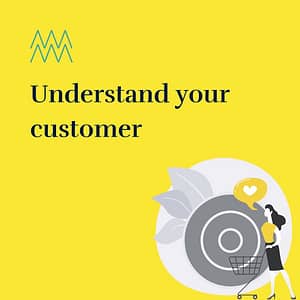Are you worried you might be wasting marketing budget on activities that aren’t delivering a return? In one survey, respondents approximated that 26% of their marketing budgets are squandered on fruitless channels and strategies. Does this sound familiar? 😫
Improving the return on your marketing investment is a no-brainer. It’s an easy place to start recouping and tightening business expenses. By its very nature, marketing should create value and a profit, not a dent on the balance sheet.
Be reassured that there are several steps you can take to maximise your marketing budget. Many of the service-based business owners I work with now run successful and efficient marketing campaigns since reviewing their activities and re-allocating budget strategically.
When it comes to making improvements and driving growth, I’m a big advocate for auditing your business before making any drastic changes. Follow the 7 ways to stop wasting your marketing budget below.
1. Website usability and conversion rate
How user-friendly is your website? A bad user experience could mean 88% of website visitors may not return. You need to make it as easy and intuitive as possible for potential customers to navigate and purchase from your site.
Website usability testing comes in handy here. Essentially, finding representative users from your target audience, asking them to do particular tasks on the website, observing them, and analysing the results. From there, you can make changes to the website that should directly improve the functionality and in turn, your website conversion rate.
A further way to improve your conversion rate is to invest in an expert that can help with CRO (conversion rate optimisation). When it comes to CRO I worth thinking ‘quality over quantity’ – make the most out of the website visitors you already have rather than focusing on encouraging new, possibly colder, traffic. A member of my team is a CRO expert and achieves brilliant budget-saving results with these methods.
2. Marketing and media spend
Make sure you are measuring marketing performance properly so you can see what’s working and what isn’t. This should give you a clear idea of what channels are providing a decent return on investment – not just in terms of money, but time too.
Digital marketing is a key component for most service-based businesses and media buying often eats up much of the marketing budget. By tracking your media spend and paid marketing efforts very regularly, you can keep a tight rein on what paid advertising, branded content, and display ads are working well, and ditch the ones that aren’t.
3. SEO and insights
Is your website SEO optimised? Crucial for your business to be found online, there are so many factors that can impact SEO including site speed and website responsiveness. Start by running a free SEO audit to understand what parts of your site need improvement. Google also provides an SEO starter guide that includes 5 key questions to help you strengthen your website SEO and keywords.
I’m a fan of Google Analytics and the detailed insights it provides. Use it to frequently identify new opportunities to improve SEO.
- What are your customers searching for to find you?
- How can you better support them?
- What blog post do they want to see from you next?
Insight-driven content marketing will make the most of your budget.
4. Audience targeting
If you don’t have the right audience targeting in place then spending money on ads, or marketing in general, can prove to be an ineffective investment. It’s critical to work on audience strategy before spending money on tactics. Audience targeting is a cycle – you gather a broad range of data, narrow it down to build customer profiles, segment the audiences, design appropriate campaigns, then evaluate the performance so that the next targeting strategy is more efficient.
To improve your marketing spend drastically, you need to get really specific about who you are serving which ads. Ensure you follow the right steps to understand your customer profiles – demographic, identity, location, and purchasing behaviours to name a few.
5. Paid ads
There are many factors when it comes to paid advertising that can impact how efficiently your marketing budget is being spent. These include which channels you’re using, audience targeting, objectives, metrics, creative, content, messaging, and the offer itself. Lots of precious budget is wasted because people don’t understand the nitty-gritty of paid ads – or they are using the wrong agency. That is often a big money-burner.
An important point to look at is how the pandemic has influenced paid ads. User and advertiser behaviours have shifted massively, so whilst previously you might have been spending money on Facebook ads, that budget may now be better spent on paid search or a platform outside of the box like online radio or TikTok. Google estimates that for every $1 a business spends on Google Ads, they receive $8 in profit through Google Search and Ads – an average ROI of 800%. If that’s accurate for your business in practice it’s well worth doing. However, note here Google search ads aren’t for every business and it’s very easy to waste money on PPC if you (or your agency) don’t know how it all works.
6. Marketing team
Is your marketing team properly trained and do they understand what they are doing? If they don’t and they can’t manage the agencies properly then this is a recipe for disaster.
Invest in your team, make sure that they have the capabilities they need and if they don’t, then get them training. In terms of time and money, it’s often worth training up your existing team rather than re-hiring – you’d be surprised at the impact on your marketing budget too.
A good marketing strategy includes a team that has been properly briefed, on-boarded, and understands the objectives, whether to increase brand exposure, gain more social media followers, grow an email list, improve conversion rates, or drive more click-throughs on paid ads.
7. Customer journey
This is a big one as many small but scaling businesses haven’t had the time to focus on this and these fundamentals can be overlooked. But there are several reasons why the customer journey is so important. So this is a reminder to review and improve every touchpoint.
Go right back to the start –
- How do your prospects hear about you in the first place?
- How do you then turn them into a lead? The know, like, and trust factors come in here.
- Then, how are you nurturing your leads to turn them into customers?
- The customer journey doesn’t stop once you’ve made a sale.
- You want repeat customers and referrals – the main way to achieve this is through exceptional customer service.
Map out the entire journey, even using good old-fashioned pen and paper, and ask yourself: how can you add value, be on brand, and deliver great service at every touchpoint?
I did this with a client and they saw a 10% increase in renewal rate which resulted in a massive impact on their profit.
To sum up
Improving any one of these 7 steps can have a significant impact on your profit, if it’s more than one then it could be a game-changer. I know it works because I have worked with clients who have had:
✅ 42% decrease in cost per sale
✅ 10% increase in renewal rate (on a premium service)
✅ Happy team members that are properly trained and less likely to leave (which if they do is a huge cost to the business)
✅ Saved £120K on agency fees over 12 months
Need more support?
If you aren’t sure it’s your marketing that’s stopping your business from growing, complete the FREE Ultimate Growth Audit to receive valuable insights on scaling your business.
I work with service-based businesses looking to scale and grow by providing one-to-one consultancy and a strategic growth plan that covers the key points above. Have a read of how I helped Cognomie create a marketing strategy and plan for growth that resulted in over 360K funding.
👉 Find out more about how I can help you and connect with me on LinkedIn.



